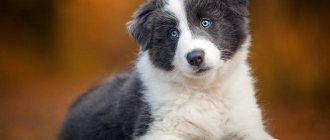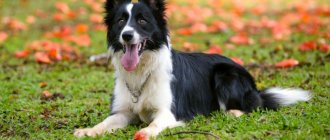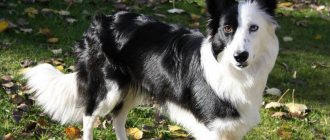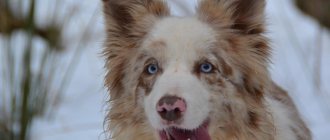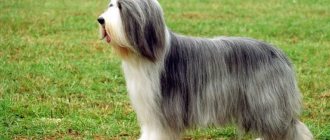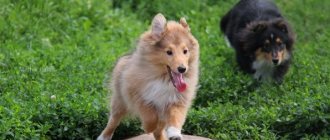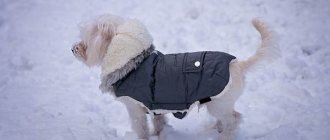The value of the Border Collie breed lies in its almost complete absence of disadvantages. These animals have the highest intelligence, hard work, and delicacy. From time immemorial they have been faithful friends, companions and helpers of man. The border collie's boundless devotion, combined with its affectionate, patient spirit, continues to win the hearts of fans to this day.
Breed variety
Description
Border collies are the best representatives of herding dogs. They are often called the smartest of all dog species in the world. Collies are excellent working dogs due to their agility and endurance. The animals have always been a favorite choice of farmers and ranchers as they have successfully assisted in herding livestock. If you are ready to raise your animal with love, train it consistently and fairly, and give it plenty of exercise, this is the breed for you.
Reviews
Alina, 20 years old: “I lead an active lifestyle: I love hiking, cycling, and skiing in winter. My border collie shares this rhythm with me. At one year old, the dog already knew all the commands, there were no problems with training.”
Valery, 40 years old: “I chose a dog as a companion for children. It’s hard for them to find a better companion than a border collie. Our Rick runs around with them in the yard all day, and in the evening he has a fuss at home. There was never a time when he somehow offended the children. On the contrary, sometimes I yell at them so that they don’t bother the collies too much. But he seems to like it."
Inga, 51 years old: “My acquaintance with the border collie began when I saw this dog in some movie and simply fell in love from the first frame with this energetic and intelligent animal. I have kept this breed for over 15 years. Each dog is unique, with its own character and habits. I have up to 5 collies at a time. They need a lot of space. I couldn’t live in an apartment with a border.”
Appearance
— Advertising —
The parameters of the individuals are as follows:
- male height: 48-56 cm, weight – 14-20 kg;
- height of females: 46-53 cm, weight – 12-19 kg.
The description says that the dog has an athletic and muscular body. Everything about this pet shows its strength: muscular legs, standing body, neck and wide chest. They are agile individuals that move with grace and stealth.
The skull is quite wide, the back of the head is not pronounced. The teeth and jaws are strong, with a perfect scissor bite. This means that the upper teeth closely overlap the lower teeth and fit into the jaws.
— Advertising —
Medium-sized ears tend to stand erect or partially erect.
A distinctive feature of the pets is their almond-shaped eyes and intense gaze. It reflects their high level of intelligence and ability to accurately focus on sheep or other objects. Eye color is usually brown, although some individuals have brown or blue eyes. There are also animals with different eyes.
When viewed from the front, the limbs are parallel; when viewed from the side, the pasterns are slightly inclined.
The paws are oval shaped, with strong and durable pads. The fingers are arched and close to each other. The claws are short and strong.
The tail is moderately long, reaching at least to the hock joint.
The coat of pets can be short-haired or moderately long-haired, as well as long-haired. In both cases, the topcoat is dense and medium in texture, while the undercoat is soft and dense. It provides weather resistance.
The coat color is usually black with white spots. Dogs also come in many colors, combinations and patterns. The colors of this smooth-haired animal can be as follows:
- Black and white.
- Tricolor.
- Blue merle.
- Blue merle tricolor.
- Red.
- Red tricolor.
- Red merle.
- Red merle tricolor.
- Blue.
- Grey.
- Merle slate.
- Lilac, lilac or lilac.
- Lilac tricolor.
- Sable.
- Brindle.
- Brown.
- Chocolate.
- Marble.
- Golden.
- Spotted.
Pros and cons of a dog
Pros of the type:
- This is a highly intelligent pet. No wonder it was called the most intelligent species in the world.
- They love to play. If you want an animal that will play with you for hours and anywhere, then this is the species for you.
- You will be surprised by the high level of intelligence of the species.
- You will need to devote a lot of time to exercise.
- Dogs get along well with children.
- They are one of the healthiest and hardiest breeds in the world.
- This is one of the few species in the American Kennel Club for which the breed standard is quite simple.
Disadvantages of the type:
- Animals crave attention. If individuals do not receive it, they may even bite owners and other people.
- Dogs can be very territorial.
- If you do not allow the animal to expend energy, this will lead to destructive actions on its part.
- If you live in a private house, take care of a high fence and gate. These individuals love to run away.
- Your pet needs time to socialize. Dogs are usually shy and reserved.
- Your pet can outsmart you if you let it. And he will do this constantly in the future.
- If your pet does not receive enough mental stimulation, it can lead to an eating disorder.
- This breed is not suitable for home guarding.
- Pets may shed several times a year. Therefore, the species is unlikely to be suitable for allergy sufferers.
History of the origin of the breed
Start
In the 1st century, the Romans brought these dogs to the British Isles and used them as herders. The animals spread very quickly throughout Britain, as well as Wales, Ireland and Scotland.
Later, the Roman Empire fell and England was invaded by the Vikings. Then another type of animal appeared, which looked like a Spitz.
These pets were bred together with larger species. As a result, we got medium-sized dogs with longer fur. They were better adapted to the geography and climate of the British Isles. These animals were also distinguished by their ability to herd livestock and were dexterous and athletic. They are considered the predecessors of the modern border collie.
One of these pets was a dog named Old Hemp.
Old Hemp
This animal was born in September 1893 at West Woodburn, Northumberland. His parents were a black shepherd named Meg and a calico cattle dog named Roy.
Old Hemp didn't look like modern border collies. He had a tricolor coat and minimal white fur, but he was an extraordinary dog. Old Hemp demonstrated his great herding abilities while still a puppy. He was only six weeks old then. The dog's owner and breeder, Adam Telfer, was impressed by Old Hemp's intelligence, natural instincts and ability to herd livestock. Soon, Hemp became the main working dog on the farm.
The owner had a lot of experience with sheepdogs, but had never seen an animal like Old Hemp before.
The dog's reputation as an outstanding herder made him very popular as a dog. People throughout the region wanted puppies born from this legendary herding animal. So they constantly brought their girls to Telfer's farm. According to some reports, up to 200 puppies were born to Old Hemp.
Most of the descendants retained the character traits that made Hemp such a wonderful shepherd. As well as its physical characteristics, including its coarse coat and medium build. This pet is considered the ancestor of the Border Collie breed.
Old Hemp is listed in the studbook of the International Sheepdog Society, which was founded in Scotland in 1906.
Later, Telfer had a dog named Sweep, the grandson of Old Hemp. This pet has succeeded in competitions for shepherd dogs.
He has twice won the International Sheepdog Society's Sheepdog Trials Championship.
Another famous descendant of Old Hemp is a dog named Young Hemp. He was the winner of the International Farmers' Sheepdog Championship in 1924.
Between 1906 and 1951, every one of the twenty-nine dogs that competed in this championship was a descendant of Old Hemp.
Other herding dog breeders took notice of the qualities that made the breed's founder such a superior animal. They sought to imitate these traits when breeding their pets.
origin of name
The first word in the name – border – means “border”. This refers to the area where the dogs were bred. It lies on the border between England and Scotland.
The term "collie" has a more complex etymology. The word collie is believed to come from the Celtic language and mean "helpful."
Other evidence suggests that sheep in the Scottish Highlands are known for their black markings. And "collie" is an old Anglo-Saxon word that means black.
Confession
The International Sheepdog Society is located today in Bedford, England. This organization maintains careful records of Border Collie breedings throughout the world.
It was thanks to their efforts that the American Kennel Club officially recognized the Border Collie in 1995.
Cattle dog
The entire life of animals is connected with grazing.
The species is specially bred to chase and organize animals. Border Collies are particularly good herders due to their independence and intelligence. The need to “flock” is so deeply ingrained in these dogs that some owners have to rent sheep for their pets.
Description of Border Collie
Canine ratings based on scientific research call the Border Collie the smartest dog breed. And boarders fully confirm this thesis in practice. They work not only as shepherds: they serve in the police, become guides for the blind, pet therapists for people who have experienced severe stress, and simply excellent companions for their owners who lead an active lifestyle.
The FCI standard assigns the breed an individual number 297 and classifies it in the first group (“Shepherd and cattle dogs”), in the first section (“Shepherd dogs with working tests”). The latest updates to the standard date back to 2009.
Appearance
Border owners consider their appearance to be ideal, and they are indeed very harmonious, well-proportioned dogs, full of charm and positivity.
These are very beautiful and harmonious dogs
Table: Border Collie breed conformation according to FCI standard
| Main articles | Description |
| Dimensions |
|
| Addition |
|
| Head |
|
| Limbs |
|
| Tail |
|
| Wool |
|
| Colors |
|
Working Border Collies have developed a special, creeping gait
The peculiarity of the breed also lies in its movements: only border dogs can run at a swift, creeping trot, almost hugging the ground. Almost exactly the same way a cat moves, silently approaching its prey.
Photo gallery: some border collie color options
Zoned gray color variants are quite rare in the breed
With a blue color, not only white spots are acceptable, but also tan
This is a rare, short-haired blue merle color that shares the same standard with the long-haired variety.
Blue eyes are allowed for any merle color; for other colors the eyes must be brown.
If the Border Collie has a chocolate color, it is also acceptable to have a tan color.
With lilac coloration, the eyes may be amber-yellow.
Border collies of a blue merle tricolor color look unusually elegant
The golden-white color looks sophisticated and elegant.
Black and white individuals are currently the most common in the breed
In black tricolor dogs, the tan can be either pure red or brindle.
For a border collie, the brown merle color can be called exclusive - it is so rare
Character and behavior
They are smart, cheerful and efficient, which makes them better than many other breeds. But sometimes owners suddenly notice with amazement that their pet seems to have been replaced: he has become wayward, uncontrollable and disobedient, and when left alone at home, he completely destroys the apartment: he chews and breaks things, although he has long since left puppyhood. What's happened?
The Border Collie is playful, creative and very active.
In this case, as in all similar cases, the dog is not to blame. The owner is to blame, because for some reason he began to pay less attention to his pet. Border does not understand why this happened, he is nervous, bored and tries to attract attention to himself in every way possible.
This is a very affectionate and completely non-aggressive dog. He adores his owner and his entire family, gets along well with small children, although he can frighten them with his excessive activity. He gets along well with dogs of any breed and size, but other small animals - cats, rodents and birds - are best not placed in the same house with him: the border dog may show too much interest in them.
Disqualities and dog disadvantages
Aggressiveness or, conversely, cowardice of a dog is a reason for its disqualification at the exhibition and removal from breeding work. As for the exterior, the disqualifying defect is most often the color, or more precisely, the dominance of white in it.
A dog of this color will be disqualified from the exhibition, however, in kennels that deal with working dogs, piebald border collies are often found
The smartest dog
Any fan of the species will tell you that the breed is recognized as the smartest in the world. What exactly does this mean? A dog is considered "smart" by human standards, which are based on a number of factors. In his book The Intelligence of Dogs, British Columbia neuropsychologist Stanley Coren uses training of an animal to show its level of intelligence. The man examined a professional trainer's ratings for 110 breeds, which are based on animal testing and obedience testing. Koren called the smartest dogs those that quickly obeyed certain commands. The peculiarity was that the individuals heard the commands five or less times, and reproduced them with 95% success. The best result was shown by the Border Collie breed.
Colors and coat types
The vast majority of representatives of the Border Collie breed have a black and white coat. The gene carrying it is the most active and monochormic puppies can be obtained from the mating of dogs of any color. The spots look like tan marks or brindle, specks.
- Blue coat color in collies is obtained by combining a black dominant and an allele that weakens it. The spots are sometimes modified to a pure blue color.
- Tricolor dogs are allowed in different color variations.
- brown individuals are heterozygous for all colors except their own.
- The red color varies from light cream to bright sable. It is caused by complex gene interactions. Dogs with such hair can even give birth to black babies.
- Merle in the breed results in puppies with a marbled tint. Similar colors often appear in Border Collies, but are difficult to see until the dog matures.
- white spots are a mandatory requirement for the breed; they can be marked with spots of any color.
- It is not customary for dogs of blue merle color to be bred with each other; they produce few, non-viable offspring. They select relatives of a different color as partners.
- The marbled dog is more likely than others to be born with different eyes or have a wedge-shaped contrasting mark on the iris.
Snow-white hair is not recognized as a standard, but such dogs are sometimes born and are in special demand in a number of countries.
Maintenance and care
How to care for a dog?
If you make it a regular part of your lifestyle, caring for your pet will not be a difficult task. Features of the content are as follows.
There are many basic essentials that you should buy for your pet. Buy a leash, collar, food, toys, a crib and comb, special shampoo, and nail clippers. Avoid retractable leashes as they can strangle your pet. Instead, choose a long leash. When choosing a leash, consider the circumference of your friend's neck. Usually it is 33-36 cm.
Cleaning. There are two types of fur that an animal can have. The first is smooth and relatively short fur. The second is thick and smooth hairs that grow up to 7 cm. To reduce flaking of the skin, both types should be combed out frequently. However, the long-haired variety should be brushed daily to prevent pellets from forming in the coat. The ideal tools for the procedure are a metal brush or comb.
Nail cutting. The animal's claws should be trimmed once a month. If you have difficulty completing this task at home, take him to a professional groomer or veterinarian. Use special dog nail clippers for the procedure. Alternatively, you can also buy a nail file to round off the sharp edges.
Ear cleaning. You should look into your dog's ears at two weeks. This is necessary to make sure that they are clean and healthy. If you notice wax on the surface, simply wipe it with a clean, soft, damp cloth.
Teeth cleaning. Brush your pet's teeth every few days. Use a soft-bristled toothbrush and toothpaste specifically designed for dogs. Pay special attention to the back teeth, as caries most often forms there.
Bathing. The animal does not have a strong dog smell - it does not smell like a dog. Therefore, only bathe him when he is very dirty. Try not to carry out the procedure in winter. In general, the breed should not be washed more than twice a year. It is recommended to use dry shampoo for bathing.
Rest. Set up a secluded place for your pet to rest and sleep. Buy a special bed or make a crib yourself.
Activity. Make sure your pet gets plenty of exercise. Due to the high amount of energy, he needs to exercise for one hour every day. Walk your animal outside 2 times daily.
Take your pet to the vet regularly and get vaccinations according to schedule.
Walk, walk like that!
The Border Collie's need for physical activity is not just high, but super high! He is literally dying without the opportunity to frolic. Twice a day for 45 minutes is the minimum time that every Einstein owner is required to devote to walking their pet. On a three-point scale, the need for physical activity in a border collie is a three with a lot of pluses.
Walks can be not only on foot, but also by bicycle: a faithful friend will not refuse either a run behind or in front of the owner’s vehicle, or the burning sensation while riding on a trunk.
And keep in mind: these “crazy cars” run at the speed of thought!
Playing games while walking is a proven way to quickly satiate your dog's thirst for willpower, especially if you are a good slingshot shooter and can throw a tennis ball quite far.
Nutrition
This species rarely suffers from allergies, unlike other breeds. They are also less likely to have health problems, although their activity may cause joint problems later in life. In terms of nutrition, the breed is quite easy to satisfy. Individuals do not have any special needs. But, of course, there are certain ingredients that will be beneficial for dogs.
Squirrels . Like humans, animals break down protein to produce certain amino acids. They support growth, promote tissue repair and enzyme production.
Too much protein can have an adverse effect on the animal's behavior. This can make your pet hyperactive, unfocused, lack concentration, and even lead to unpredictable behavior.
If your pet walks a lot, goes for a run with you, and you regularly do daily interactive training, he will need about 22% protein.
If the dog is pregnant or sick, it is better to feed it food with a higher protein level - up to 24%.
Fats . The right kind of fat is essential to keeping your pet's skin and coat healthy. This will also give your pet an extra boost of energy.
Calcium will help maintain healthy bones and joints.
This breed is not picky and can tolerate all food components. But you should be careful about consuming too many carbohydrates. You can find them in almost all types of feed. Some feeds provide the animal with carbohydrates by 70%.
A growing individual requires 1,400 calories per day as they are more likely to be very active. For adults, 1000 calories is enough. As this breed gets older, their activity and amount of energy decreases. Therefore, older animals need about 700 calories per day.
Dogs cannot control their food intake on their own. They will eat everything you put in front of them. Divide your calorie intake into two separate meals. It's up to you to decide whether it will be breakfast and dinner or lunch and dinner.
Many dog owners, regardless of breed, choose dry food. This is due to the fact that it is more accessible. Others buy canned food.
You can also cook your pet's food yourself. But here you will have to carefully calculate the diet and calorie content of the dishes in order to provide the animals with all the necessary substances.
Girl
The height at the withers for girls is 46-53 cm, weight – 12-19 kg.
Females are usually shorter and slimmer. This contributes to their greater dexterity. Also, girls' heads have a more feminine appearance.
Women are usually more independent than men and do not like to be controlled. For example, they will come to you when they want something, but will leave as soon as they get what they wanted.
Because women like to be in control, they tend to be more stubborn.
A lesser known fact is that girls are territorial. They will mark their territory throughout their lives. This does not depend on whether they are sterilized.
Bitches are less attached to their owner than males. With age, they become more reserved.
Unspayed females will exhibit mood swings when they come into heat. In general, women tend to be more “moody” than men.
Boy
The height at the withers for boys is 48-56 cm, their weight is 14-20 kg.
Generally, the males of the same litter will be larger in size than the females. They usually grow taller and have a more muscular body, but this depends on the litter the dog was born into. Some parents may be small and some may be large. Therefore, some women may be larger than men purely due to genetics.
Males, as a rule, are more attached to their owners than females. They exhibit more affectionate behavior. Boys tend to be more "pushy" and will often ask you for attention.
As a male dog ages, he is more likely to retain his puppy playfulness. Females are the opposite: they become more withdrawn and aloof with age.
Often, male dogs will be more food motivated than female dogs. This has clear advantages in education and training.
We can say that men have a more “even” character. They are often calmer.
Nicknames
Many owners can't figure out what to name their Border Collie? Below are the most popular pet names.
For boy
Nicknames for boys:
- Hemp.
- They beat.
- Jet.
- Millennium.
- Clyde.
- Tyne.
- Rocky.
- Chester.
- Winston.
- Jimmy.
- Jack.
- Ben.
- Luke.
- Cody.
- Bean.
- Pete.
- Royan.
- False.
- Jesse.
- Whale.
- Dylan.
- Evan.
- Weiss.
- Schleich.
- Luke.
- Moody.
For girl
Nicknames for girls:
- Jen.
- Meg.
- Bessie.
- Ruby.
- Nellie.
- Annie.
- Haze.
- Barra.
- Dera.
- Jilly.
- Jena.
- Queen.
- Redhead.
- Molly.
- Bark.
- Mia.
- Fairy.
- Lussy.
- Sky.
- Merry.
- Faith.
- Martha.
- Omega.
Lifespan
Border collies live from 10 to 17 years. The following will help increase the active and fulfilling life of representatives of this breed:
- timely vaccinations;
- carefully balanced regular meals;
- physical activity of proper intensity;
- games and tasks for intelligence.
Border collies live from 10 to 17 years
Breeding
Breeding individuals is a difficult and labor-intensive process. Serious breeders check dogs according to many criteria, including the presence of genetic diseases.
Puberty in males occurs at the age of 15 months, in females - at 18 months. The female's first estrus begins at 6 months and occurs 2 times a year.
Get all necessary vaccinations and deworming a month before the expected mating date.
Pregnancy lasts 53-71 days. Walk a lot with the expectant mother, but do not overtire her. Provide the female with a high protein diet.
Shortly before giving birth, the bitch's behavior will begin to change. She will stop eating, will start to worry, and will dig her place. If you observe these signs, it means that there is less than a day left before the significant event.
Ensure that a veterinarian or experienced breeder is present at the birth.
Usually 4-8 puppies are born in a litter.
Puppies
Puppies of the species are long-legged, fluffy and very active.
Babies grow at an average rate and stop growing after about a year.
Weight and height of puppies, depending on age:
| Age, months | Height, cm | Weight, kg |
| 1 | 10-12 | 1,8-2 |
| 2 | 15-17 | 4-5 |
| 3 | 20-22 | 6-7 |
| 4 | 28-30 | 9-10 |
| 5 | 33-35 | 10-12 |
| 6 | 35-38 | 12-14 |
| 7 | 38-40 | 14-15 |
| 8 | 40-43 | 15-16 |
| 9 | 43-45 | 15-16,5 |
| 10 | 45-47 | 15,5-17 |
| 11 | 45-48 | 15-17,5 |
| 12-14 | 45-56 | 15-20 |
Their curiosity can lead them where they shouldn't. So you must remove all wires, things, and foods that your pet might chew or eat.
Don't let animals chase children, cyclists or other dogs. Early behavior modification will help control these urges.
Breeders and veterinarians have come to the conclusion that the owner can replace the animal's food with a brand of his choice. It is best to do this when your pet has been living with you for about a month. Do it gradually. Give your baby some time to adjust at first to make the transition easier. Combine about 75% old food and 25% new food in a bowl for the first day or two. On days 3 and 4, feed the animal about 50% old and 50% new food. And then, on days 5 and 6, move to a ratio of 75% new and 25% old food. Your pet should be fully adapted to the new diet by the 7th day.
Animals may become allergic to certain foods, causing their gut bacteria to be destroyed by the new diet. If the dog has not adapted to the new food, you can return to the old one. This may be indicated by refusal of food, vomiting, and diarrhea.
There are many different types of food available on the market today. So you have options to choose from! A balanced diet is very important. It affects your puppy's growth, future health and well-being.
Thus, you need to provide the animal with the necessary amount of vitamins, minerals, antioxidants, amino acids, carbohydrates, fats and other elements. Babies need additional nutrients, such as calcium. They also need about twice as many calories per 2 kg of body weight as adults.
Both dry and canned food are easily digestible. Veterinarians recommend choosing one that depends on your preferences, budget and lifestyle.
The amount fed varies depending on factors such as breed, activity and body condition.
Puppies should be fed more often than adults. Start with 4-6 meals a day. Reduce them to 2-3 small meals per day after 6 months. Start feeding your pet 1-2 times a day when he is one year old. Do not overfeed individuals! Research shows that dogs live longer and have fewer health problems if their diet is restricted early in life.
Puppy cost
The price of a puppy depends on its origin.
- You can buy a baby from your own hands, the seller will claim that the litter is the result of an unscheduled mating, so there are no documents, offer to see mom and dad live or from a photo and ask for about 1,000 to 5,000 rubles. It is unknown who will grow out of the toddler in the future. Such a dog is prohibited from entering exhibitions, it is not subject to breeding, and after a while it may develop various diseases.
- For a puppy of titled parents who participated in exhibitions, with a full set of documents, you will have to pay 10-25 thousand rubles. A less distinguished, promising baby with a metric mark and a rare color will cost the same.
- Over 20 thousand rubles. The kids are show class. They even look different. It is advisable to buy such a dog if you plan to attend exhibitions, engage in breeding, or start a kennel.
Sales advertisements can also be found on free service websites. But in them, would-be breeders often try to pass off mestizos as purebred puppies, citing the lack of documents as the reason that they didn’t want the paperwork.
Dog character
When it comes to temperament, Border Collies are quite different from most other breeds. They are truly unique and individual dogs, with their own little quirks.
The nature of collies is closely related to their “work” as herders. Therefore, almost everything they do comes from their instinct to herd other animals.
Any individual of this species will be very energetic. This energy leads to a love of play and a desire or even need to run. A responsible owner must be prepared to perform the tasks associated with training the dog.
They are very sociable and friendly. Pets are people-oriented, despite the “herd” mentality. They are very friendly and loyal. Individuals also get along well with cats and other pets.
Since pets are strongly attached to their owners, they suffer from long separations. Don't let them stay alone for long. This will lead to destructive behavior in the home.
Collies are not an aggressive breed. Therefore, they do not have strong security abilities and a tendency to fight.
Animals love their families and show this as best they can. But they will be more reserved around unfamiliar people and animals.
When young, the breed may exhibit sensitivity to noise and a general lack of confidence in the world. However, when they are carefully trained and socialized, individuals make excellent companions and workers. They are very intelligent creatures. They are considered one of the smartest dog species in the world. Therefore, animals will often try to outsmart their owners. Don't let them do this, as it will become a habit for your pets.
Thanks to their high intelligence, individuals quickly learn new tricks and commands.
And we got our character from our great-grandmother
- They are playful. Border Collies love all kinds of games that require physical activity, which is why they quickly find a common language with children who highly share their interests.
- They are friendly. If a cat appears on the way of a border collie, it will rather want to get to know each other better than bare its teeth in a threat. This breed is also peaceful towards its relatives.
- They are born nannies. If you don't have sheep, but have chickens or free-grazing geese, then Border Collies will certainly take care of them. And if you have neither chickens nor geese, but have children, then in extreme cases they will also be suitable for the role of pets who need the guardianship of this cute dog. Of course, the option with sheep is the ideal use of all the talents and abilities of “Einsteins on four legs.”
- They are very smart. The natural intelligence of the Border Collie can and should be developed. The quick learning abilities of these dogs require constant training, otherwise you risk losing their talent. An Austrian Border Collie living near Vienna knows 340 human words! No, she doesn't talk, but she can bring exactly what she is told. In order for the dog to obey unquestioningly, the owner needs to have unquestionable authority, otherwise the training will turn out to be “zilch”.
- They are hyperactive. This character trait cannot withstand limited space, so the comfort of a city apartment can drive even such a sweet and good-natured creature as a border collie crazy. They need space of meadows and fields; at worst, a city park will do.
- They are workaholics. Border collies love to play pranks, but they never refuse to work. The main thing is that the owner is nearby. If you don’t come up with an activity for her, she will find one herself! And there is no certainty that you will like the results of the work of this “clump of energy”. Numerous holes in the lawn or chewed and gutted sofa cushions - these are the most modest surprises that your friend, bored with idleness, can prepare for you.
- They are spontaneous. This breed is capable of maintaining playfulness even into adulthood, so do not expect the sedateness and importance of a pug from a border collie.
- They are artistic. We can say that dogs of this breed have an innate need for all kinds of tricks. Moreover, they perform their clown acts with no less pleasure than the audience receives. Border collies have been successfully featured in films many times.
- They are hospitable. Collies are quite good with strangers, so frequent house guests will not be a problem for her.
Education and training
At what age should you start training your pet?
The answer to this question largely depends on the type of training. If you're talking about teaching your pet simple house rules, the sooner you start, the better.
However, if you are trying to teach your puppy some new basic tricks, you should wait until your baby is 3 months old.
If you want to teach your animal something more complex, then you should wait until the age of 5 to 6 months.
As a trainer, you start by assigning yourself the role of “Alpha Dog.” This means that you are the leader, and the dog completely obeys you.
Some key tips for successful collie training:
- Pay full attention to your pet. You must also be attentive to your pet if you want him to learn anything. Choose a time and place with the least amount of distractions before you begin training your animal.
- Always be consistent. This is necessary so that your pet learns everything as quickly as possible during training. Don't change the team names. Pick one and stick to it. If you are trying to teach your dog to stay away from furniture, follow this principle at all times. You shouldn't have specific days when your pet can or can't get on the couch. This will only slow down learning and confuse your pet.
- Use positive reinforcement. Animals learn better through reward rather than punishment. Always reward good behavior, either with a treat or just praise. This is the best way to show your pet that he is doing something right. This will also motivate the dog to do the same thing again.
- Have patience. If you are upset, training will be difficult for you and your animal. If you have been training your pet for a long time, and he still does not accept your commands, do not yell at him. Training your animal with a firm and gentle voice always works great.
How to choose a puppy
A purebred puppy of good origin and with show potential can cost on average about one and a half thousand dollars. Such a high cost provokes scammers to pass off cute mongrels as representatives of an elite breed. To some extent, this is facilitated by the democratic nature of the standard, which allows for an extremely wide variety of breeds.
Growing puppy requires special attention
However, the standard also regulates characteristics that are unchanged for all breed types of border collies - knowledge of some of them will help you in choosing a puppy. So, what you need to pay attention to:
- on the head - the border has a very sharp transition from the forehead to the muzzle (stop), but the occipital protuberance is practically not palpable;
- for wool - its length is not so important as its quality, the awn should be dense and elastic, and the undercoat should be thick and soft, this protects borderers from bad weather;
- on movements - only the Border Collie has a special, “cat-like” gait on half-bent legs; it clearly distinguishes this breed from all others.
Even very small Border Collie puppies show miracles of intelligence
Diseases
Once you have fully explored the pros and cons of the breed's personality, it is time to consider their potential health problems. Unlike some other species, the Border Collie is relatively healthy. But there are some of the most common health problems specific to this breed:
- The eye anomaly occurs in puppies and dogs under two years of age. This is an inherited disease that affects the uvea in the eye. Its role is to supply oxygen to the retina of the eye. The disease can lead to thinning of the choroid. And then, to blindness and intraocular hemorrhage. There is no cure for this problem. In mild cases, the disorder may not get worse and therefore does not require treatment. In severe cases, surgery may be required to relieve some symptoms. Discuss all treatment options with your veterinarian.
- Dysplasia of the hip and elbow joints. Hip dysplasia is an extremely common orthopedic condition in dogs. It is estimated that 70% of individuals are affected by it. Elbow dysplasia is less common but can also occur in this species. As in the previous case, elbow and hip dysplasia are genetic diseases. They can appear in animals at any age. As the joints develop, the femoral head dislocates. The joint wears down over time, causing pain, stiffness, an unusual gait, and other symptoms. Your veterinarian will help you determine a treatment plan based on the severity of your symptoms. The condition is controlled with painkillers and physical rehabilitation. Surgery may be required.
- Osteochondritis. Cartilage acts as a buffer for the joint. When the disease occurs, the cartilage in your pet's joints begins to break down. Without it, the joint becomes mobile and painful. The disease occurs in puppies from the age of four months. Contact your veterinarian and he will prescribe a treatment plan. Most often, the specialist will recommend surgery or arthroscopy (minimally invasive surgical procedure).
- Progressive retinal atrophy. This is a degenerative condition that gradually impairs your dog's vision. Ultimately, it leads to blindness. There is no cure for retinal atrophy. But you can improve your pet's condition with medications. Border collies are so intelligent that they often adapt well to vision loss. You will need to ensure that their habitat remains safe.
- Epilepsy. The main symptom of the problem is seizures. Signs of epilepsy in an animal may appear during the first six months of life. Currently, there is no screening test to detect this disease. Medications are most often used to treat epilepsy. Understanding the signs of an epileptic seizure and how to treat it is also important for proper treatment. Consult your veterinarian who will prescribe a treatment regimen.
- Hypothyroidism. With this disease, the dog's thyroid gland does not produce enough hormones. Some signs that your pet may have hypothyroidism include: dry skin, dull coat, weight gain, hair loss, aggression and behavioral changes. Diagnosis is a simple blood test. If your pet is confirmed to have hypothyroidism, your veterinarian will prescribe medication to balance the production of thyroid hormones. After this, symptoms should disappear within a few weeks. Sometimes the dosage must be changed several times. Once the correct dosage is found, have your blood tested periodically. You will be giving medications to your pet for the rest of its life.
- Dental problems are quite common in this species. The accumulation of tartar and plaque around the gum line can lead to tooth decay and tooth loss, as occurs in humans. Clean your friend's mouth regularly.
- Heart diseases. Congenital heart disease is a common genetic defect of the species. This condition usually results in congestion of blood on the left side of the heart. In severe cases, it causes heart failure and death. Symptoms: shortness of breath when walking and exercising, lethargy. Contact your veterinarian for a diagnosis.
Owner reviews
Border collie owners consider their pets to be the main assistants for those who have decided to lead a truly healthy lifestyle. Daily walks lasting from 3 to 6 hours in the company of an active and intelligent four-legged friend bring clear and tangible benefits.
Border collie owners are happy to note that their loyal, intelligent, easy-to-keep dogs know the names of all their relatives and friends, and can also perform quite complex tricks even with amateur training.
Work for the body, tasks for the mind, games for pleasure - the main components of a happy tandem of a man and a border collie
Dogs of this breed, to one degree or another, naturally display an innate tendency to “herd” those around them. Owners advise from a very early age to wean your pet from “herding” people, and in walking areas where other dogs are present, to take the border collie on a leash so that it does not suddenly begin to herd its four-legged brothers into the flock.
If you have to leave a dog of this breed alone at home for a long time, some recommend using a spacious and secure crate.
Interesting Facts
- Old Hemp is not the only Border Collie who has had a profound influence on the development of the breed. Whiston Cap was born in 1963 and became the most prolific collie in history. It is estimated that every Border Collie in the UK is currently descended from him. And also each individual registered with the International Sheepdog Society represents 13.3% of Wiston Cap.
- Queen Victoria was a true dog lover. In the early 1860s she became an active Border Collie enthusiast.
- The famous Scottish Poet Laureate Robert Burns was a proponent of the species. He described the breed as honest and loyal. Burns and his brother had a pet named Luat as children. But he died tragically. Burns's poem "Twa Dogs" is partly an ode to Luath. And the Burns statue in Winthrop Square in Boston depicts Luath standing eternally at his master's side.
- Animals know how and love to act in films and television shows due to their high intelligence, as well as workaholism. One of the most famous examples is the Maui pet. He played the dog Murray. The dog belonged to the main characters in the sitcom Mad About You, which aired in the 1990s. Maui played Murray for seven seasons, and was twice named the most popular dog on television by TV Guide.
- Talented border collie Striker currently holds one of the strangest Guinness World Records: "Fastest car window opening." Striker took 11.34 seconds to open a non-electric car window using its paw and nose. He set the record in September 2004 in Quebec, Canada.
- Dogs can move quickly in a cat-like, inclined position. This is due to the space between the tops of the shoulder blades, which allows them to "glide" low to the ground. This technique helps individuals herd animals with extreme precision.
- The Chaser is widely known as the smartest dog in the world. She can understand different words and also name her 1000 unique toys.
- Queen Victoria and Robert Burns are not the only famous people who owned collies. James Dean, Anna Paquin, Bon Jovi, Ethan Hawke, James Franco and Tiger Woods all had this breed.
- Films and TV series in which this breed has starred: “Snow Dogs”, “Little House on the Prairie”, “Mad About You”, “Baby”, “Year of the Dog”, “Wuthering Heights”, “Babe: The Four-Legged Baby” and many others.
- The species is also mentioned in fiction. For example, in the book “Year of the Dog. Twelve months, four dogs and me." It was written by journalist and author John Katz. He was the owner of all those dogs that, in fact, are written about in the book.
- The main work of the species is grazing. However, animals are also good at other tasks. It has to do with their mind. Collies are often used as therapy dogs. Dogs can also warn other people about deteriorating health conditions of the patient, such as seizures.
